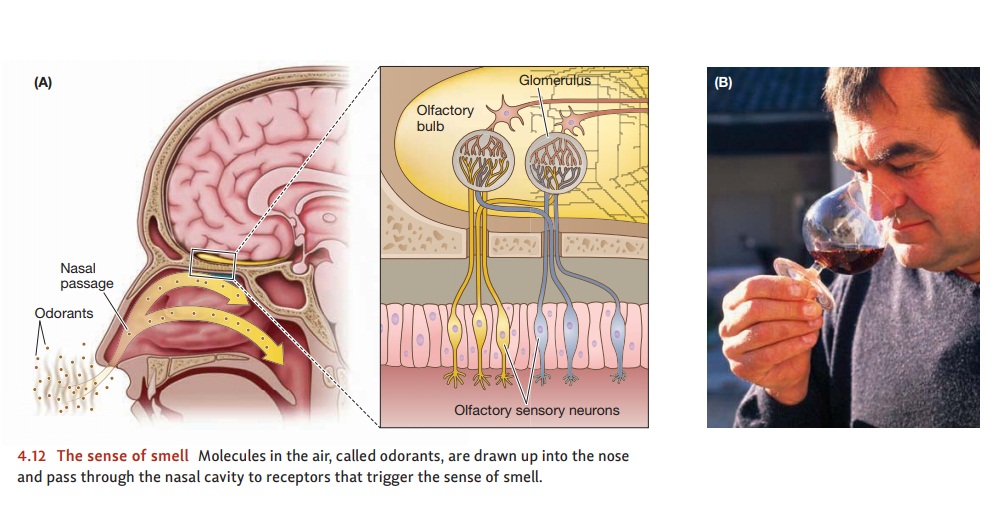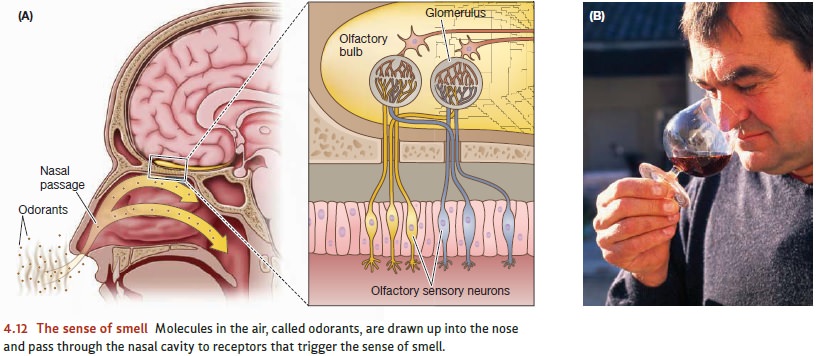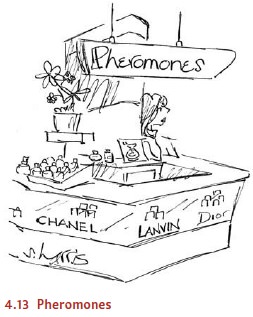Chapter: Psychology: Sensation
A Survey of the Senses: Smell

Smell
Smell may be the sense modality that
we understand least (for recent surveys, see A. Gilbert, 2008; Zarzo &
Stanton, 2009). Still, some basic facts are clear: Complex molecules drift
through the air, and some are drawn up the nose to a mucous membrane called the
olfactory epithelium—it’s located at
the top of the nasal cavity, a little less than three inches up from the
nostrils’ opening. The epithelium in each nostril con-tains roughly 10 million
olfactory receptor neurons. Some of the molecules that reach

these neurons bind to these
receptors, changing their membrane structure and thus triggering an electrical
response. The molecules that can produce a response in these receptors are
called odorants (Figure 4.12).
The axons from the receptors exit
the nasal cavity through a thin layer of bone and reach upward into the
olfactory bulb, a brain structure above the nasal cavity and just beneath the
frontal lobes. Within the olfactory bulb, the axons converge at sites called glomeruli. The nose contains roughly
1,000 types of receptors, and each glomerulusreceives input from just one of
these receptor types. Because each type of odorant binds more easily to some
types of receptors than others, we can think of each type of recep-tor as
having a “preferred” odorant. Then, with each glomerulus receiving inputs from
just one type of receptor, this preference for certain odorants is inevitably
passed along from the receptors to the glomeruli.
It’s not clear, however, how the
many glomeruli give rise to the various odors that humans can discriminate
(Axel, 1995). We’ve already mentioned the roughly 1,000 types of receptors—and
therefore 1,000 types of glomeruli—but in fact humans can distinguish roughly
10,000 different odors. Right away, these numbers tell us that our sense of
smell does not rely on a one-glomerulus-per-scent coding—we don’t rely on
“labeled lines” that use one neural pathway for each scent. Instead, it must be
that each odor we can distinguish produces some unique pattern of activation in
the various glomeruli. What this pattern is—and so exactly how the nervous
system distinguishes, say, the smell of roses from the smell of vanilla—remains
a topic for research (for a recent exploration of these issues, see Khan et
al., 2007).
The sense of smell has many
functions. Smell helps many animals to locate food— think of a bear managing to
find the ripe berries, or a dog hunting for a rabbit. Smell also helps animals
avoid danger; it’s why predators usually approach their prey from downwind, so
that the prey won’t pick up the predator’s scent. Smell also contributes
heavily to our sense of flavor—partly
because air carrying odorants can reach the nasal cavity through either the
nose or an opening at the back of the mouth. In fact, a large part of what we
call flavor—and thus a large factor in our selection (and enjoyment!) of
foods—is really smell. This point is evident whenever someone has a head cold
that impairs their sense of smell. In that situation, most foods taste
incredibly bland— strong testimony to just how much flavor involves the way
something smells, rather than how it tastes. You can test this point without
having a head cold: Pinch your nose closed, shut your eyes, and have someone
feed you either a small bit of an onion or a small bit of apple. Without visual
or smell cues, you won’t be able to tell which bit is which. Indeed, in the
laboratory, people with their nostrils blocked seem unable to tell apart
flavors as diverse as grape, coffee, chocolate, and garlic (Mozel, B. Smith, P.
Smith, Sullivan, & Swender, 1969).
Smell also has important social
functions. For some animals, smell allows one indi-vidual to recognize other
individuals—so that infant rats can recognize their mothers via smell, and
their mothers can recognize them the same way. In addition, smell can serve a
communicative function by alerting other individuals to the whereabouts or the
status of other individuals from that species. This is, of course, why many
animals mark their territories by rubbing against trees, or by depositing small
splashes of urine at var-ious landmarks within their domain. These activities
leave scent traces that announce the scent donor’s “ownership” of that bit of
real estate.
Smell-based communication within
a species usually involves specialized chemicals called pheromones—biologically produced odorants that convey information
to other members of the species. Some pheromones simply identify the species:
“Know by this smell that a fellow cat is nearby.” Other pheromones convey information
about the donor’s current state. For instance, some pheromones serve as alarm
signals— when an animal is frightened, its sweat includes chemicals that can be
detected by other members of that species, putting them on alert that some
threat is at hand (e.g., Brechbühl, Klaey, & Broillet, 2008). Other
pheromones play a role in mating—for example, helping males of the species to
locate sexually receptive females (e.g., Michael & Keverne, 1968).
There has been considerable
debate about the role of pheromonal communication in humans—especially in human
mating. We do know that human parents can sniff a T-shirt and tell by the scent
which of their children wore the shirt (R .Porter & Schaal, 1995; Wallace,
1977). We also know that human infants just a week old can dis-tinguish between
their mother’s scent and the scent of another lactating woman (Macfarlane,
1975; Cernoch & Porter, 1985). But what about a role for pheromones in
selecting a mate, or in sexual arousal itself ? Many laboratories are exploring
this issue, often with the hope of identifying some sex attractant—and, as
Figure 4.13 suggests, often with funding from the perfume industry! However,
the results of this research have been inconclusive at best (McClintock, 2000).
Even so, there’s no question that at least some aspects of human reproductive
behavior are influenced by scent. We find some evidence for this point among
young women who live together; they tend to have synchronized menstrual cycles,
ovulating and menstruating on the same days. More, this synchrony is
established relatively quickly—after the women have lived together for just 3
months (McClintock, 1971).

What causes this menstrual
synchrony? The answer turns out to be scent. In a number of experiments,
investigators have collected perspiration from the under-arms of one group of
women and then wiped these secretions under the noses of a different group of
women who’ve never met the scents’ donors. This communication via smell is
enough to establish the synchrony (Stern & McClintock, 1998)—a pow-erful
indicator that some aspects of our reproductive systems are, in fact, governed
by odor cues.
Related Topics